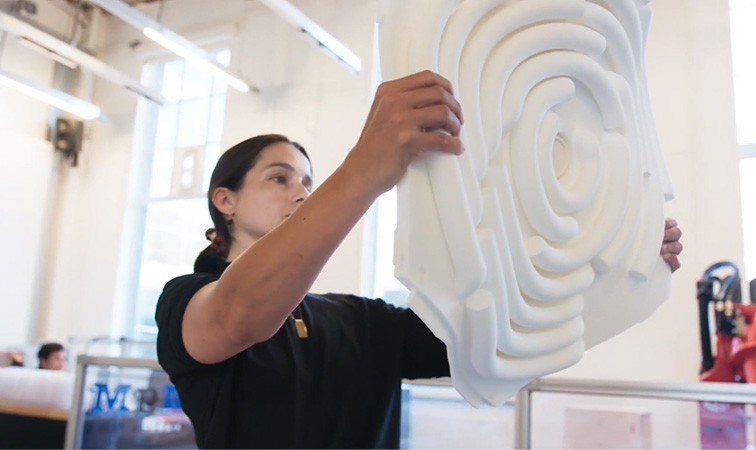The Delft University of Technology (TU Delft) has worked with Belgian 3D printing software and service provider Materialise to develop 3D printed sound absorbing acoustic panels.
Created as part of a joint multidisciplinary research project, the fabricated tiles were custom-designed to improve the acoustic and auditory experiences of those in concert halls or sports arenas. Leveraging 3D printing rather than conventional manufacturing methods, the TU Delft team were also able to create the panels at a lower cost, and in more complex geometries than was previously thought possible.
“We used additive manufacturing because of its potential to produce a large variety of complex shapes,” said Michela Turrin, Associate Professor of Design Informatics at TU Delft. “It gives a lot of freedom in the complexity of the geometry, but it also enables production to be made in unique pieces that are not necessarily based on industrial repetition.”
Controlling the sound of music
Large open spaces such as concert or exhibition halls are often utilized by performers from a variety of disciplines. As a result, venues aren’t currently optimized for the sounds generated by each individual performance, and this can lead to the creation of unflattering, irritating frequencies for both the performer and the listener.
At present, tiresome frequencies are difficult to cancel out, because conventional panels don’t provide the architectural freedom or customization necessary to effectively dampen the sound. In order to overcome this issue, TU Delft set up a multidisciplinary committee of companies and began a research project with funding from the Netherlands Organization for Scientific Research.
The overarching aim of the program was to design enhanced panels that could be used to block loud noises, or bothersome frequencies and echoes. Materialise was chosen to optimize the production element of the process, as 3D printing provides intrinsic freedom of design, and enables the creation of structures with complex geometries.
Consequently, the panels could theoretically be created in a functional way to block out specific sound frequencies, but without ruining the aesthetics of the venue.

The prototype sound-absorbing panels
Materialise’s services were combined into a digital workflow, whereby designers, architects, and engineers used 3D modeling to craft the acoustics of parts for optimal performance. During the process, the panels were custom-designed to achieve Passive Destructive Interference (PDI), a self-cancellation technique that uses a part’s own form to cancel out a specific, tuneable, frequency band.
Once the design files were ready, the parts were summarily printed using a Selective Laser Sintering (SLS) process, yielding a number of puzzle-like components. The panels, consisting of a series of tubes with varying lengths and diameters, could then be slotted together into a curved freestanding structure, capable of blocking out specific sounds and echoes.
“Inside quarter wavelength tubes, a standing wave emerges, which determines the frequency at which sound absorption appears,” explained Martin Tenpierik, Associate Professor at TU Delft. “The length and the radius of the tube both determine that specific frequency, and we can also achieve broadband sound absorption, by including different kinds of tubes in one product.”
To evaluate the performance of their panel, the researchers placed their prototypes into a ‘reverberation room,’ in which sound absorbers were used to accurately measure their acoustic performance. The structures proved to be especially effective at absorbing lower frequencies, and following the successful tests, potential clients from a range of sectors have shown an interest in the devices.
“The results are really promising, especially when it comes to lower frequencies and the reduced thickness of the applied materials,” concluded Foteini Setaki, a researcher on the project. “We are hoping that we will be able, very soon, to launch a ready product that can enter the construction industry market.”
Other acoustic additive applications
Additive manufacturing enables users to create an almost unlimited number of geometries, and this has led many researchers to experiment with the acoustic potential of the technology.
Engineers from Duke’s Pratt School of Engineering have developed 3D printed cloak cover devices, that are able to reflect sound waves as soon as they hit a designated object. The cloak alters the trajectory of waves to give the impression that they did not hit anything at all, and they progress without changing frequency.
Physicists from the University of Texas at Dallas (UT Dallas) and China’s Wuhan University have used 3D printing to create a Weyl sonic crystal cube that’s capable of reflecting sound. The novel device could inspire new research in wave manipulation such as acoustic cloaking, or advances in user electronics.
Elsewhere, guitar manufacturer Nik Huber Guitars, partnered with amorphous metal specialists Heraeus AMLOY, to install a 3D printed bridge onto one of its guitars. The amorphous metals enabled the vibrations of the instrument to be transmitted differently, improving the acoustics of the instrument.
Nominations for the 2020 3D Printing Industry Awards are still open, let us know who is leading the industry now.
The fourth edition of the 3D Printing Industry Awards Trophy Design Competition is now underway. Enter your design for the chance to win a CraftBot Flow 3D printer.
To stay up to date with the latest 3D printing news, don’t forget to subscribe to the 3D Printing Industry newsletter or follow us on Twitter or liking our page on Facebook.
Are you looking for a job in the additive manufacturing industry? Visit 3D Printing Jobs for a selection of roles in the industry.
Featured image shows a member of the TU Delft team holding one of their 3D printed prototype panels. Photo via TU Delft.



